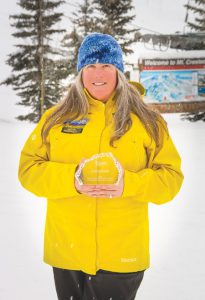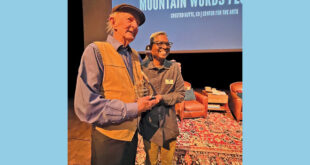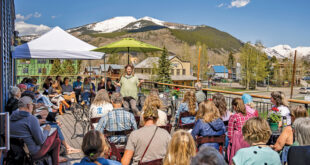by Dawne Belloise
Kirsten Atkins has been on skis since she was four years old and shussing down Killington’s slopes in Vermont, where she got her first season pass in 1972 at the age of seven.

The family lived in Connecticut but had a small place at the resort. “We had a tiny ski chalet at Killington, with brown and orange furniture, thick shag carpet and bunks for you and all your cousins,” Kirsten remembers. “We’d drive up on weekends and it didn’t matter what the weather was like.” Her parents would load up the car and the three kids and drive up Friday night. “We were always a ski family and involved in kids’ ski programs. I was on the Killington freestyle team from the time I was nine to when I was 13 years old,” but Kirsten confesses that she wasn’t that competitive and by the time she was 13, like any teenager, “I just wanted to ski with my friends.”
Kirsten graduated from high school in 1983 and moved to Killington so she could ski more and take advantage of the drinking age, which was 18 back then. To support her ski habit, she worked as a cocktail waitress at a dance club for a couple of years.
“My poor mother,” Kirsten shakes her head. “I look at 18 year olds now and they’re so young to be in an environment like that,” she says, but adds that she’s glad to have had that experience in her life. “Everything you do prepares you for the next thing in life, right?”
After her two “gap” years, Kirsten enrolled at the University of Denver and moved to the Mile High City. Her first thought was that she wanted a career in hotel and restaurant management.
“But then, I was taking all these anthropology and psychology classes and realized I was more passionate about those studies than my business classes.” In her freshman year, she opted out of skiing in order to get serious about studying.
She quickly realized that was a mistake, which she corrected the following year by taking the winter semester off and moving to Steamboat. When she returned to her classes in 1987, her friends decided that taking the winter semester off to hit the slopes was a brilliant idea; however, Steamboat didn’t allow snowboarders and her buddies were riders.
“Telluride housing was too expensive so we checked out Crested Butte on the way back to school. I came to Crested Butte, with my little clan of friends, where housing was affordable but super tight. We moved into a house next to the tennis courts… three bedrooms for seven people. And here begins my story with the Adaptive Sports Center [ASC].”
Kirsten responded to an ad in the paper for volunteers for the Crested Butte Physically Challenged Ski Program, which was the precursor of the Adaptive Sports Center. The program was born in February 1987 and Kirsten joined up with the fledging organization that November.
“It was their first full season and we were all volunteers at that point. Mary Cain and Robin Norton were the founding mothers of the program. I got involved because my older brother Keith is on the autism spectrum. Autism is a broad category of people, from quite high functioning to people who are nonverbal. My brother is pretty high functioning. I grew up as the sibling of a person with a cognitive disorder and I grew up skiing, so they were two big important parts of who I am. I got excited about volunteering for the program. We did 33 lessons that winter. Luckily, I had another job—working at the China Garden in the Elk Mountain Lodge as a waitress. I also worked at the Eldo and the Gourmet Noodle.”
When she started her volunteer work at ASC, the world of adaptive skiing was new as a sport and Kirsten has seen many changes and its evolution. “One of the biggest things that I see throughout the years is the technology advancements. It’s been an incredible thing to watch. The other part is, over the years we were experimenting with ideas, we’d look at a student and try to figure out how to make skiing happen for them.”
Kirsten and the team of volunteers used their innovation and lots of duct tape, pieces of foam and bits of everything. “I don’t have an engineering mind but luckily there were people who did and were developing this equipment. A lot of the designing was driven by people with disabilities who wanted to ski and had engineering minds.”
Some of those first pieces of equipment are conserved in the Crested Butte Museum. “I’m the program pack rat,” Kirsten laughs and explains that the history and development of the Adaptive program, its origins and how it evolved, are extremely important to her, and it’s important to educate the public.
This year, the ASC celebrates its 30th anniversary of improving the quality of life for people with disabilities through outdoor adventures. They’ve developed policies and guidelines born out of the experience of its three decades.
Kirsten recalls that in the ASC’s embryonic start, she didn’t have a lot of mentors and they had no trainers, yet the mentors who were there taught her well. New employees and volunteers at Adaptive now go through rigorous training in a variety of skills before they are allowed to take out a lesson.
“Look at the growth and development of this community,” Kirsten points out. “Thirty years ago, the streets were dirt, and people still talk about what it was like back in the day. The Adaptive program has grown up with the community and with the huge support of this community. Our program is incredibly blessed to have had that sort of support. Even when the economy crashed in 2008, we were a little nervous about how our fundraising efforts were going to go but we were able to raise what we needed.”
Kirsten’s role at Adaptive has been in training and as a snow sports supervisor. “Over the years, I developed into the then-undefined leadership role, and I wasn’t the only one in that role. I started giving training clinics for the newbies coming in. In the mid-1990s, I went to Scotland and Austria, working for the Uphill Ski Club of Great Britain, which is now the Disabled Sports UK. I trained instructors and volunteer trainings for four winters, and also taught British people with disabilities. I had only four or five instructors for 12 to 15 clients, whereas at Adaptive we had one-on-one.”
Kirsten would drive “a big ol’ van loaded with a bunch of equipment from Scotland to Austria. We’d have four or five weeks of ‘holiday makers,’ as the clients were called. I got to live in Austria and teach and meet all kinds of interesting people. I’d work part of the season there and part here in Crested Butte. We were sort of celebrities over in Scotland because not a lot of instructors were going over there at that time. We were really well treated and we were invited to all the Highland dances. I got to experience awesome culture in both Scotland and Austria.”
In the late 1990s, Adaptive took their programming to Argentina and Kirsten started teaching training clinics down there in late August 1997. They’d schlep tons of equipment because, in those early days, United Airlines would give Adaptive an unlimited baggage waiver. Kirsten tells of one year when four instructors took 19 pieces of luggage. “We would take sit skis and wrap them in shrink wrap. Some of the equipment would stay and some we brought back with us.”
She spent a couple of winter months in Argentina for 10 consecutive years, focusing on teaching the instructors and volunteers and helping them groom their own programs. “I was focusing on an education curriculum for the instructors there and we developed an instructor certification program and helped facilitate the Argentine Ski Instructor Association,” Kirsten explains.
ASC began to take its own USA clients to Argentina as part of their Adaptive Adventure Travel program in early 2000.
Overall, Adaptive Sports currently conducts about 6,000 lessons a year of both winter and summer programs. Kirsten notes that things have changed a bit. “We now have highly trained, certified and qualified staff, and lots of volunteers. In the winter, we have about 28 pass volunteers [those who are given season ski passes] and we have upwards of 100 in the winter programs.”
The group program has expanded and the groups are now the backbone of their program. There are various disabled veterans’ groups, like Operation Rise and Conquer, which is one of the veteran programs funded through ASC and through generous donors.
There is the Roger Pepper Camp for teenage burn survivors, one of the long-running camps of Adaptive. From the teen burn survivor camp comes the DC Burn Foundation, a firefighters’ group of survivors.
“We have groups that come from rehab hospitals with spinal cord and head injuries and also various research hospitals that work with MS and multiple disabilities. We have tons of different kids’ groups. A couple of weekends ago we had a group called Joy School in Texas—they’re children with learning disabilities. A lot of the groups come both summer and winter,” Kirsten says.
Summer programs offer biking, water sports, like canoeing on Irwin Lake, or camping, hiking, and rock climbing (they have ice climbing in the winter).
Adaptive recently moved into their new home office in town on Belleview, where they now have a fleet of vehicles. ASC is in the process of building a new facility on the mountain, moving their offices from the Treasury Building, where they’ve been for 28 years. “It’s a far cry from our first winter in the Emmons building in essentially a closet,” Kirsten laughs, adding that they’ve been there so long that, “We’ve circumnavigated the entire lower level of the Treasury Building, basically taking over, so, it’s time to get out of there. There are innovative and progressive spaces being designed into the new building.”
Last winter, Kirsten made a big decision: “So, here we are, it’s my 30th winter here. I had been in the leadership role since Adaptive’s early days, and now, I’ve decided to take a step back. I didn’t want to leave the program because it’s part of my heart and soul, part of my fabric and community here. I’ve been passionate about it my whole life, especially growing up with a brother with a disability. I still work for the Professional Ski Instructors Association–RM [Rocky Mountain], the certification and education for snow sports, and I’ve been working for them for 10 years.”
Although she’s not leaving the program she loves, Kirsten and her hubby, Heath, are working on an exciting new venture. “We’ve bought 73 acres across from Crested Butte South and we’re working to develop the Crested Butte Horse Park. Our vision is to create a safe facility for horse and rider, with the expectation for it to be of high quality, aesthetically pleasing, as green as possible and promote equine lessons and services.”
This past December, Kirsten was honored with an induction into the Disabled Sports USA Hall of Fame. It’s an online national recognition that acknowledges the efforts of both athletes and instructors throughout the entire country, inducting one athlete and one instructor each year. Kirsten feels that there are many more sports that can be expanded to enrich the lives of the disabled. And after 30 years, she’s still there to help create that.
 The Crested Butte News Serving the Gunnison Valley since 1999
The Crested Butte News Serving the Gunnison Valley since 1999




